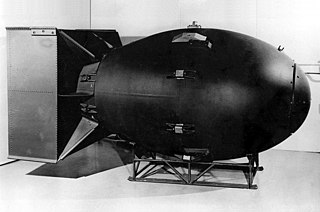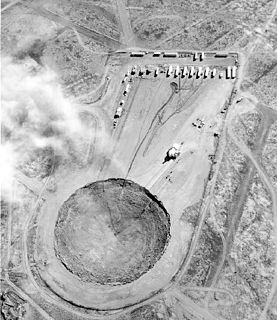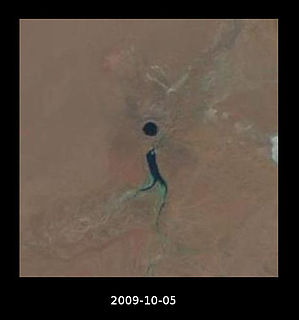
K-141 Kursk was an Oscar II-class nuclear-powered cruise-missile submarine of the Russian Navy.

The Tunguska event was a large explosion that occurred near the Stony Tunguska River in Yeniseysk Governorate, Russia, on the morning of 30 June 1908 (NS). The explosion over the sparsely populated Eastern Siberian Taiga flattened 2,000 square kilometres of forest, yet caused no known human casualties. The explosion is generally attributed to the air burst of a meteor. It is classified as an impact event, even though no impact crater has been found; the object is thought to have disintegrated at an altitude of 5 to 10 kilometres rather than to have hit the surface of the Earth.
On May 25, 1865, in Mobile, Alabama, in the Southern United States, an ordnance depot or "magazine" exploded, killing some 300 persons. This event occurred just after the end of the American Civil War, during the occupation of the city by victorious Federal troops.
Igor Dmitriyevich Novikov is a Russian theoretical astrophysicist and cosmologist.

In general relativity, a white hole is a hypothetical region of spacetime which cannot be entered from the outside, although matter and light can escape from it. In this sense, it is the reverse of a black hole, which can only be entered from the outside and from which matter and light cannot escape. White holes appear in the theory of eternal black holes. In addition to a black hole region in the future, such a solution of the Einstein field equations has a white hole region in its past. However, this region does not exist for black holes that have formed through gravitational collapse, nor are there any known physical processes through which a white hole could be formed. Although information and evidence regarding white holes remains inconclusive, the 2006 GRB 060614 has been proposed as the first documented occurrence of a white hole.

Nipawin is a town in north-east Saskatchewan, Canada, on the Saskatchewan River portion of Tobin Lake. The town lies between Codette Lake, created by the Francois-Finlay Dam and Tobin Lake, created by the E.B. Campbell Dam built in 1963, renamed from Squaw Rapids. The construction of Francois-Finlay Dam earned Nipawin the nickname, The Town of Two Lakes.

Nuclear weapons tests are experiments carried out to determine the effectiveness, yield, and explosive capability of nuclear weapons. Throughout the twentieth century, most nations that developed nuclear weapons tested them. Testing nuclear weapons can yield information about how the weapons work, as well as how the weapons behave under various conditions and how personnel, structures, and equipment behave when subjected to nuclear explosions. Nuclear testing has often been used as an indicator of scientific and military strength, and many tests have been overtly political in their intention; most nuclear weapons states publicly declared their nuclear status by means of a nuclear test.

A subsidence crater is a hole or depression left on the surface of an area which has had an underground explosion. Many such craters are present at the Nevada Test Site, which is no longer in use for nuclear testing.

The Flaming Geyser State Park is located on the Green River in southwestern King County, Washington, near the city of Black Diamond. The park was named for a flame which burned through a concrete basin, fueled by a methane gas pocket 1,000 feet below the surface. When the pocket was discovered by prospective coal miners in the early 1900s, the test hole hit gas and saltwater, shooting water and flames 25 feet into the air. The same methane pocket seeps gas through a mud hole to create the "Bubbling Geyser" nearby. Both "geysers" can be found along a short hike, though as of 2016 the flaming geyser is no longer lit due to depletion of its methane source.

Lake Chagan, Kazakhstan, is a lake created by the Chagan nuclear test fired on January 15, 1965, part of the Nuclear Explosions for the National Economy. A 140 kiloton device was placed in a 178-metre (584 ft) deep hole in the dry bed of the Chagan River. The blast created a crater 400 m (1,300 ft) across and 100 m (330 ft) deep with a lip height of 20 to 38 m .; it is often referred to as "Atomic Lake".

The sinking of the nuclear-powered Oscar-class submarine Kursk, took place during the first major Russian naval exercise in more than ten years, in the Barents Sea on 12 August 2000, killing all 118 personnel on board. Nearby ships registered the initial explosion and a second, much larger, explosion which registered 4.2 on the Richter scale on seismographs as far away as Alaska, yet the Russian Navy did not realise that the sub had sunk and did not initiate a search for more than six hours. By the time it declared an emergency 11 hours later, the crew were—unknown to anyone—all dead. Because the sub's emergency rescue buoy had been intentionally disabled, it took more than 16 hours to locate the sunken boat.
Nuclear Explosions for the National Economy was a Soviet program to investigate peaceful nuclear explosions (PNEs). It was analogous to the United States program Operation Plowshare.

The Jilin chemical plant explosions were a series of explosions which occurred on November 13, 2005, in the No.101 Petrochemical Plant in Jilin City, Jilin Province, China, over the period of an hour. The explosions killed six, injured dozens, and caused the evacuation of tens of thousands of residents.

Sarychev Peak ,
is a stratovolcano covering almost the entirety of Matua Island in the Kuril Islands, Russia. It is a young, highly symmetrical stratovolcanic cone.

USS Hinsdale (APA-120) was a Haskell-class attack transport of the US Navy. She was built and used during World War II and was of the VC2-S-AP5 Victory ship design type. Hinsdale was named for Hinsdale County, Colorado.

Lake Chebarkul is a lake in Chebarkulsky District, Chelyabinsk Oblast, Russia, on the slopes of the southern Urals. The town of Chebarkul lies on its eastern shore, and Chelyabinsk, the administrative center of Chelyabinsk Oblast, is located about 70 kilometres (43 mi) to the northeast. The name of the lake, and the city of the same name, comes from Turkic and means "Beautiful, colorful lake."

The Chelyabinsk meteor was a superbolide caused by an approximately 20 m (66 ft) near-Earth asteroid that entered Earth's atmosphere over Russia on 15 February 2013 at about 09:20 YEKT, with a speed of 19.16 ± 0.15 kilometres per second. It quickly became a brilliant superbolide meteor over the southern Ural region. The light from the meteor was brighter than the Sun, visible up to 100 km (62 mi) away. It was observed over a wide area of the region and in neighbouring republics. Some eyewitnesses also felt intense heat from the fireball.

On 3 April 2017, a terrorist attack using an explosive device took place on the Saint Petersburg Metro between Sennaya Ploshchad and Tekhnologichesky Institut stations. Seven people were initially reported to have died, and eight more died later from their injuries, bringing the total to 15.
The following is a timeline of the Syrian Civil War from January to April 2019. Information about aggregated casualty counts is found at Casualties of the Syrian Civil War.

















